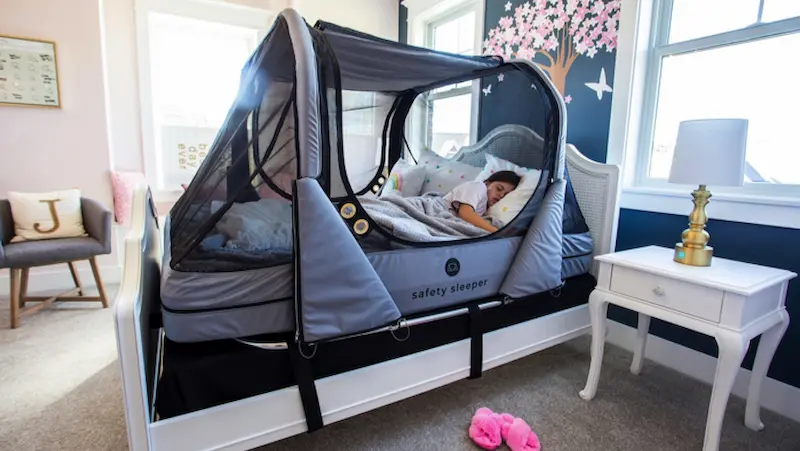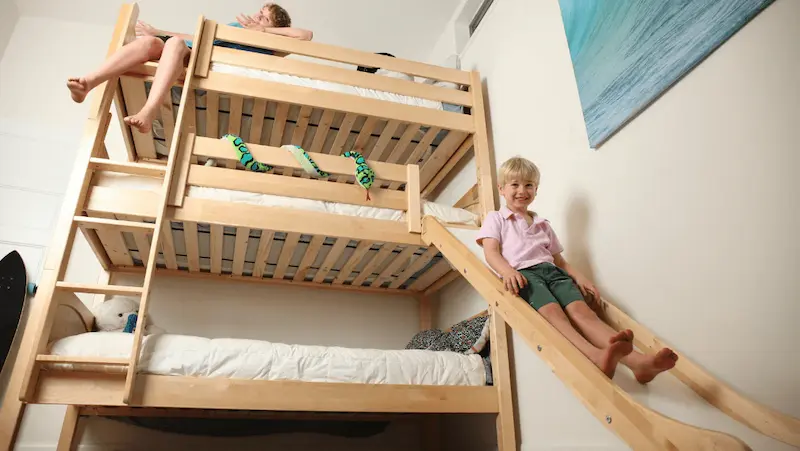Are your kids struggling to get a good night’s sleep? Create the perfect sleep-friendly space for them with these design tips. From calming colors and cozy bedding to soothing lighting and organized spaces, discover how to transform their room into a haven for restful nights and sweet dreams.
Table of contents
Introduction
Creating a sleep-friendly environment for children is crucial for their overall well-being. Quality sleep plays a vital role in their physical and mental development. A conducive sleep space promotes relaxation, reduces bedtime struggles, and enhances sleep duration.
It supports healthy brain function, boosts memory, strengthens the immune system, and improves mood and behavior. Providing children with a peaceful and comfortable sleep environment sets the foundation for a healthy lifestyle and ensures they wake up refreshed and ready for each day’s adventures.

Understanding the Basics of Sleep
Consistency in sleep schedules and routines is essential for children’s well-being. It helps regulate their internal body clocks, known as circadian rhythms, promoting better sleep quality and duration. Consistent bedtimes and wake-up times create a predictable sleep pattern, allowing their bodies to adjust and optimize restorative sleep.
Regular sleep routines signal to their brains that it’s time to wind down, helping them relax and prepare for sleep. Here are some recommended Sleep Duration for Different Age Groups by Global Experts:
1. Newborns (0-3 months): 14-17 hours of sleep per day, including naps.
2. Infants (4-11 months): 12-15 hours of sleep per day, including naps.
3. Toddlers (1-2 years): 11-14 hours of sleep per day, including naps.
4. Preschoolers (3-5 years): 10-13 hours of sleep per day, including naps.
5. School-age children (6-13 years): 9-11 hours of sleep per day.
6. Teenagers (14-17 years): 8-10 hours of sleep per day.
7. Adults (18+ years): 7-9 hours of sleep per day.
Here are some tips for Creating a Calming Bedtime Routine:
1. Establish a Consistent Routine: Set a regular bedtime and wake-up time, maintaining consistency even on weekends.
2. Wind Down Time: Create a quiet and calm atmosphere before bed, engaging in relaxing activities such as reading, listening to soft music, or taking a warm bath.
3. Limit Screen Time: Avoid electronic devices like smartphones, tablets, and TVs at least an hour before bedtime, as the blue light emitted can interfere with sleep.
4. Create a Cozy Environment: Ensure the sleep space is comfortable, dark, and at a cool temperature.
5. Relaxation Techniques: Practice deep breathing exercises, gentle stretches, or guided imagery to promote relaxation.
6. Avoid Stimulants: Restrict consumption of caffeine or sugary snacks close to bedtime.
7. Provide Comforting Bedtime Rituals: Incorporate soothing activities like storytelling, cuddling, or singing lullabies to create a sense of security and comfort.
8. Consistency is Key: Follow the bedtime routine consistently, reinforcing the association between these activities and sleep.
By understanding sleep duration recommendations, maintaining consistent schedules, and implementing calming bedtime routines, you can help ensure that your children have the best chance of achieving quality sleep and waking up refreshed each day.

Choosing the Right Bedroom Layout
Ideally, a bedroom should be located away from noisy areas such as the living room or kitchen. Select a room that offers peace and quiet, minimizing disturbances that could disrupt sleep.
Additionally, consider bedrooms that are not directly adjacent to busy streets or areas with excessive external noise. Here are some suitable Bedroom Size and Layout ideas:
1. Sufficient Space: Aim for a bedroom size that allows for comfortable movement and accommodates essential furniture and storage without feeling cramped.
2. Natural Light: Look for a bedroom with windows that allow natural light to enter during the day, as exposure to natural light promotes healthy sleep-wake cycles.
3. Privacy: Ensure the bedroom is private and provides a sense of personal space, especially for older children and teenagers.
Some Furniture Placement for Comfort and Safety tips:
1. Bed Placement: Position the bed against a solid wall, preferably not sharing a wall with a bathroom or noisy areas. This promotes a feeling of stability and reduces noise disturbances.
2. Safety Considerations: Keep the bed away from windows to prevent drafts and potential accidents. Install window guards or safety devices if necessary. Also, ensure that electrical outlets are covered or out of reach for younger children.
3. Storage Solutions: Maximize floor space by choosing furniture with built-in storage, such as beds with drawers or shelves. This helps keep the room organized and clutter-free.
4. Study Area: If there’s space, create a dedicated study area with a desk and chair, providing a quiet place for children to focus on homework or reading.
5. Play Area: Consider incorporating a designated play area with appropriate storage for toys and games, encouraging a separation between playtime and sleep.
Remember, the overall goal is to create a bedroom layout that promotes relaxation, comfort, and safety. By selecting a suitable location within the house, choosing an appropriate bedroom size and layout, and optimizing furniture placement, you can create a sleep-friendly environment that meets the needs of your child or children.

Colors and Lighting
Colors can have a significant impact on mood and sleep quality. Bright and vibrant colors tend to be energizing and stimulating, which may not be conducive to relaxation and sleep. On the other hand, soft and soothing colors can create a calm and peaceful atmosphere, promoting better sleep.
It’s essential to choose colors that evoke a sense of tranquility and serenity for the bedroom environment. Here are some soothing Color Schemes for the Bedroom:
1. Cool Blues: Shades of light blue and pale turquoise can create a serene and tranquil atmosphere, reminiscent of a clear sky or calm waters.
2. Soft Greens: Pale green or sage hues can evoke a sense of nature and promote a calming effect, similar to being in a peaceful garden.
3. Calm Neutrals: Neutral colors like light beige, soft gray, or creamy white can create a soothing backdrop that complements various decor styles and promotes relaxation.
If you desire to gain additional information regarding coding programs for kids. Read this article!
Importance of Natural Light and Controlling Artificial Lighting:
1. Natural Light: Exposure to natural light during the day helps regulate the body’s internal clock and promotes a healthy sleep-wake cycle. Whenever possible, maximize natural light in the bedroom by keeping windows unobstructed during the day.
2. Window Treatments: Use light-filtering or blackout curtains to control the amount of natural light entering the room, especially during bedtime and naptime. This can help create a dark and restful sleep environment.
3. Artificial Lighting: Use warm and dimmable artificial lighting in the bedroom to create a cozy atmosphere. Harsh or bright overhead lighting can be disruptive to sleep. Instead, opt for bedside lamps or wall sconces that provide soft and adjustable lighting for reading or winding down before sleep.
4. Night Lights: For children who prefer a night light, choose ones with warm and soft illumination that won’t interfere with their sleep. Consider motion-activated night lights or those with timers that automatically turn off after a certain period.
By selecting soothing color schemes, leveraging natural light, and controlling artificial lighting, you can create a sleep-friendly environment that promotes relaxation and optimal sleep quality for your child’s bedroom.

Creating a Peaceful Ambiance
Calming sounds, such as gentle rain, ocean waves, or soft instrumental music, can help create a soothing atmosphere in the bedroom. These sounds can mask disruptive noises from outside and promote relaxation.
White noise machines or apps can generate a steady and consistent sound that masks other sounds in the environment. This can be particularly helpful for children who are easily disturbed by external noises.
Benefits of Blackout Curtains or Blinds:
– Blackout curtains or blinds are designed to block out external light sources, creating a dark sleep environment. They can be especially useful for bedrooms exposed to streetlights or early morning sunlight, helping to promote deeper and more restful sleep.
– The absence of light from blackout curtains or blinds signals to the brain that it’s time to sleep, enhancing the body’s natural sleep-wake cycle.
Reducing Noise and Distractions in the Bedroom:
– Minimize electronics: Keep electronic devices, such as TVs, computers, and gaming consoles, out of the bedroom. These devices can be both visually and audibly stimulating, making it harder to relax and fall asleep.
– Soften footsteps: Consider using rugs or carpets to reduce the noise of footsteps, especially if the bedroom is located above a noisy area of the house.
– Soundproofing: If the bedroom is particularly susceptible to external noise, you can explore soundproofing options such as using sound-absorbing materials or adding weatherstripping to doors and windows.
– Organize and declutter: A tidy and organized bedroom can help create a calm and peaceful atmosphere. Minimizing clutter reduces visual distractions, promoting a sense of tranquility.
By incorporating calming sounds or white noise, using blackout curtains or blinds, and reducing noise and distractions in the bedroom, you can create a peaceful ambiance that supports a restful sleep environment for your child.

Choosing the Right Bed and Bedding
The bed should be age-appropriate to ensure safety and comfort. For younger children, consider cribs, toddler beds, or twin beds with appropriate safety features like guardrails.
As children grow, they may transition to larger beds such as full or queen-size. Consider their size and future growth when selecting the bed to provide enough space for comfortable sleep.
Guidance on Choosing a Comfortable Mattress and Pillows:
– Mattress: Look for a mattress that provides proper support and comfort. Medium-firm mattresses are generally recommended as they offer a balance between support and softness. Consider the mattress material, such as memory foam or innerspring, and test it for comfort before making a decision.
– Pillows: Choose pillows that offer appropriate support for your child’s head and neck. Consider factors like firmness, material (such as memory foam or hypoallergenic options), and any specific needs like allergy sensitivities or respiratory issues.
Tips on Selecting Breathable and Hypoallergenic Bedding Materials:
– Bedding materials should be breathable to help regulate body temperature during sleep. Look for natural fibers like cotton or bamboo, which allow air circulation and wick away moisture.
– Hypoallergenic bedding is essential for children with allergies or sensitivities. Opt for bedding made from hypoallergenic materials like organic cotton or microfiber that are less likely to harbor allergens like dust mites.
– Consider using mattress and pillow protectors that are waterproof and hypoallergenic to safeguard against spills, stains, and allergens.
Remember to regularly check the bed and bedding for signs of wear and replace them as needed to maintain comfort, support, and hygiene. By selecting an age-appropriate bed, choosing a comfortable mattress and pillows, and opting for breathable and hypoallergenic bedding materials, you can ensure that your child has a comfortable and safe sleep environment that promotes restful nights and overall well-being.

Storage and Organization
An organized bedroom promotes a sense of calm and relaxation, making it easier for children to unwind and fall asleep. A clutter-free environment reduces visual distractions, allowing the mind to relax and focus on rest. Organized storage systems make it easier to find and access essential items, saving time and reducing stress during the bedtime routine.
Creative Storage Solutions to Keep the Room Clutter-Free:
– Utilize under-bed storage: Invest in storage containers or drawers designed to fit under the bed. These are ideal for storing items like extra bedding, seasonal clothing, or toys.
– Install wall shelves: Mount shelves on the walls to maximize vertical storage space. Use them for displaying books, toys, or decorative items.
– Use bins and baskets: Place bins or baskets on shelves or in closets to store smaller items, such as toys, accessories, or art supplies. Label them for easy identification and organization.
– Incorporate multi-purpose furniture: Choose furniture pieces with built-in storage, such as ottomans, bed frames with drawers, or desks with compartments.
– Hang organizers: Install over-the-door organizers or hanging pockets on the back of doors to store shoes, small toys, or accessories.
Tips on Involving Children in the Cleaning and Organizing Process:
– Set a routine: Establish regular cleaning and organizing times as part of the child’s daily or weekly schedule.
– Make it a game: Turn cleaning and organizing into a fun activity by creating challenges or setting a timer to see how quickly tasks can be completed.
– Offer rewards: Provide incentives for their efforts, such as a special treat, additional playtime, or a small allowance.
– Provide guidance: Teach children the importance of keeping their space organized and explain how it contributes to better sleep and overall well-being.
– Lead by example: Show your child the importance of organization by keeping your own space tidy and involving them in organizing other areas of the home.
By maintaining an organized bedroom, utilizing creative storage solutions, and involving children in the cleaning and organizing process, you create a calming environment that promotes better sleep and instills valuable life skills in your child.

Personalization and Comfort
Allowing children to personalize their bedroom space gives them a sense of ownership and identity, fostering a greater sense of comfort and belonging. Personalization helps create a space that reflects their individual interests, preferences, and personality, which can contribute to a positive emotional connection and overall well-being. When children feel a sense of ownership over their space, they are more likely to take pride in keeping it clean and organized.
Ideas for Incorporating Interests and Hobbies into Decor:
– Display artwork: Showcase their artwork or crafts on a dedicated wall or bulletin board. Frame their masterpieces or create a gallery wall to celebrate their creativity.
– Themed decor: Incorporate their favorite themes, such as animals, sports, or space, into wall decals, bedding, curtains, or posters.
– DIY projects: Involve them in DIY projects to personalize items like lampshades, picture frames, or shelving units with their favorite colors or patterns.
Creating Cozy Reading or Relaxation Corners:
– Comfortable seating: Provide a cozy chair, bean bag, or floor cushions in a corner of the room for reading or relaxation.
– Soft lighting: Place a small reading lamp or string lights near the reading area to create a warm and inviting ambiance.
– Bookshelves: Install or dedicate a bookshelf to house their favorite books, encouraging a love for reading.
– Snuggle nook: Add a soft blanket or a canopy above a corner of the bed or seating area to create a cozy and inviting space.
Remember to involve your child in the decision-making process and allow them to express their creativity and personal style. By incorporating their interests and hobbies, creating a cozy reading or relaxation corner, and providing opportunities for personalization, you help cultivate a space where they feel comfortable, inspired, and at ease.

Safety Considerations
Essential Safety Measures for a Sleep-Friendly Environment:
– Anchor furniture: Secure heavy furniture such as dressers, bookshelves, and TV stands to the wall to prevent tipping accidents.
– Fire safety: Install smoke detectors and carbon monoxide detectors in or near the bedroom and regularly check their functionality. Have a fire escape plan in place and educate your child about it.
– Cord safety: Keep cords of blinds, curtains, and electronics out of reach or use cordless options to prevent strangulation hazards.
– Secure windows and balconies: Install window guards or safety devices to prevent falls from windows or balconies, especially on higher floors.
– Electrical safety: Ensure all electrical outlets in the bedroom have childproof covers or use tamper-resistant outlets to prevent accidents.
– Eliminate choking hazards: Keep small objects, toys with small parts, and loose hardware out of reach of young children to prevent choking incidents.
Importance of Childproofing the Bedroom:
– Childproofing the bedroom helps create a safe environment where children can sleep and play without unnecessary risks.
– It minimizes the potential for accidents, injuries, and choking hazards, providing peace of mind for both parents and children.
– Childproofing measures ensure that the bedroom remains a secure space as children grow and explore their surroundings.
Tips for Choosing Safe Window Treatments, Furniture, and Electrical Outlets:
– Window treatments: Avoid long curtain cords or blinds with looped cords, as they pose a strangulation hazard. Opt for cordless or motorized options, or use cord safety devices to keep cords out of reach.
– Furniture safety: Choose furniture with rounded edges to prevent injuries from accidental bumps or falls. Ensure that drawers and doors have safety mechanisms to prevent pinched fingers.
– Electrical outlets: Use outlet covers or plates that have built-in childproof features to protect children from electrical shocks. Consider using outlet covers that automatically close when not in use.
– Furniture stability: Check furniture stability before purchasing or using it in the bedroom. Ensure that it meets safety standards and is designed to be secure and sturdy.
Regularly assess and update safety measures as your child grows and develops new abilities. Supervise younger children in the bedroom to ensure their safety, and educate older children about potential hazards and safe practices.
By implementing essential safety measures, childproofing the bedroom, and choosing safe window treatments, furniture, and electrical outlets, you create a sleep-friendly environment that prioritizes the well-being and security of your child.

Explore more about best robotics for kids here
Conclusion
Designing the perfect sleep-friendly space for your kids involves considering various aspects that contribute to their well-being and quality of sleep. From understanding the recommended sleep duration for different age groups to creating a calming bedtime routine, every detail plays a role.
Colors and lighting, storage and organization, personalization, and safety considerations all contribute to a peaceful and comfortable environment. By prioritizing comfort, personalization, safety, and organization, you can create a bedroom that promotes restful nights, supports healthy sleep habits, and nurtures your child’s physical and mental well-being.
With a sleep-friendly space, your children can enjoy the benefits of quality sleep and wake up refreshed, ready for each day’s adventures. Also, BrightChamps provides a comprehensive platform for learning about money for kids, offering interactive and engaging resources that teach financial literacy, budgeting, saving, and other essential money management skills.
Frequently Asked Questions
Designing a sleep-friendly space for kids is important because it promotes healthy sleep habits, enhances their overall well-being, and helps them wake up refreshed and ready for the day.
Key elements to consider include colors and lighting, storage and organization, comfort through appropriate bedding and furniture, safety measures, and personalization reflecting the child’s interests.
Create a calming color scheme by incorporating soft blues, greens, or calm neutrals like beige or gray. These colors promote a soothing and tranquil atmosphere.
Soft, warm lighting is best for promoting sleep in a child’s room. Avoid bright overhead lights and opt for bedside lamps or dimmable lighting options.
Choose breathable and hypoallergenic materials like cotton or bamboo for bedding and fabrics. These materials promote air circulation and minimize allergens, enhancing the sleep-friendly environment.
Consider incorporating sleep aids like white noise machines or calming music players. Soft stuffed animals or cozy blankets can also provide comfort and a sense of security.
Maintain proper temperature and ventilation by ensuring the room is neither too hot nor too cold. Use fans or adjust the thermostat accordingly for optimal comfort.
Place the bed against a solid wall and ensure furniture arrangement allows for easy movement and a sense of stability. Avoid clutter and maintain a spacious layout.
Use rugs or carpets to minimize noise from footsteps and consider soundproofing options for walls and doors. Use white noise machines to mask external sounds if needed.
Establish a consistent sleep routine with regular bedtimes and wake-up times. Incorporate calming activities before bed, such as reading or gentle stretching, to signal the body for sleep.


 We are an army of educators and passionate learners from BrightChamps family, committed to providing free learning resources to kids, parents & students.
We are an army of educators and passionate learners from BrightChamps family, committed to providing free learning resources to kids, parents & students.







